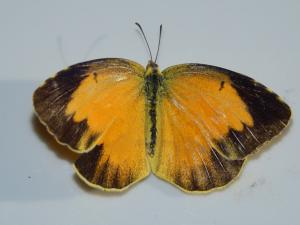UH researchers identify new butterfly species to Hawaiian Islands
University of Hawaiʻi at MānoaProfessor, Plant and Environmental Protection Sciences
William Haines, (808) 956-6745
Researcher, Plant and Environmental Protection Sciences
UHM Professor Daniel Rubinoff and researcher William Haines of the Department of Plant and Environmental Protection Sciences, College of Tropical Agriculture and Human Resources, have conclusively identified a newcomer to the Hawaiian Islands: the Sleepy Orange butterfly (Abaeis nicippe). The last time a new butterfly was identified in Hawai‘i was in 2008, when the Lesser Grass Blue (Zizina otis) was found.
The Sleepy Orange is widespread in the U.S. South; it occurs as far south as Brazil and may stray as far north as Canada when populations are high enough. It was first seen in December 2013 in Waialua on the North Shore of O‘ahu, and then on other parts of the island. Within a year it had become common on Maui and had also been found on Kaua‘i, Moloka‘i, Hawaiʻi Island and Kaho‘olawe.
“The speed with which the Sleepy Orange is establishing itself in Hawai‘i is remarkable,” said Dr. Rubinoff, “especially considering how many instances of single-island endemism — insect species isolated on a single island — exist in this archipelago.” The butterfly’s range is broad as well, from sea level to 6,800 feet up the slopes of Haleakala.
Elsewhere A. nicippe has distinct summer and winter forms, but in Hawai‘i only the summer coloration has been seen, even during the winter. It is golden yellow with dark brown markings, including speckles on the underside of the wings and a wide band around the edges of the wings on its upper side. It is about 2 inches across at its wings’ widest span. The winter coloration is reddish-brown. The larvae are green and slightly fuzzy looking. Contrary to its name, the Sleepy Orange is a very rapid and erratic flier, pausing only to take nectar from flowers or to sip water from mud puddles.
The larvae of the Sleepy Orange feed on Senna sp., which do not include any food crops grown in the state but do include the popular shower tree. However, Drs. Rubinoff and Haines do not believe that it poses a threat to this or other ornamental landscape plants in the Islands.
“The butterfly is unlikely to build up numbers sufficient to threaten ornamental plants, and it has not been recorded feeding on any native Hawaiian plants at this time,” Dr. Rubinoff explains. “While Hawai‘i has again dodged a bullet with this probably harmless introduction, it does go to show that we need to contribute more resources towards quarantine and reduce our reliance on imports, since the butterfly was almost certainly brought in accidentally on imports from the mainland.”
For more information, visit: http://www.ctahr.hawaii.edu


